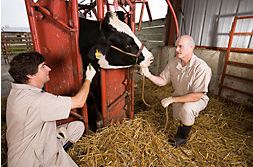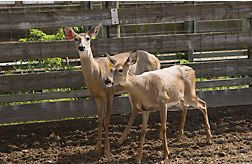



How Can We Protect Against Bovine Tuberculosis?
American research is striving to combat tuberculosis on many fronts. Researchers are sharpening up diagnosis in cattle and conducting experimental vaccination programmes on an Iowa deer herd - a known vector of the disease.The work is part of a conscious effort to address confusion shrouding testing for the bacteria which is from the same family as Johne's disease - the mycobacteria family.
Staff at the Agricultural Research Service and the National Animal Disease Centre are working on skin and tissue tests to offer greater accuracy in identifying infected cattle and a vaccination programme on deer to reduce tuberculosis in the wildlife reservoir.
New Tests for Bovine TB
Great progress has been made to eradicate bovine TB in U.S. cattle, and infection rates are low. However, M. bovis still persists in wildlife, which can transmit it to cattle. In addition, more reliable tests are needed to detect TB-positive cattle from Mexico before they are imported into the United States.
"While the diagnostic tuberculin skin test for cattle is helpful in slowing the spread of bovine TB, it is not sensitive enough, and requires a 72-hour waiting period for results," says NADC veterinary medical officer Mitch Palmer.

Also, the skin test may not be able to detect all TB-positive animals in a large herd, he says. When an animal is infected with TB, the entire herd is euthanized in most cases.
Palmer and his colleagues are working to develop a better test which will allow producers to identify and remove infected cattle and keep TB-free animals. They are investigating antigens, which are components of foreign bacteria or viruses within the body that cause the immune system to produce a response.
Their research is already paying off. A new serum TB diagnostic test was recently developed by IDEXX Laboratories, Inc., in Westbrook, Maine, based on NADC scientists' findings that an antigen called MPB83 is useful in bovine TB antibody-based tests.
"This was a team effort," says NADC veterinary medical officer Ray Waters. "IDEXX used samples from our experimental infection trials, and we helped the company validate and optimize the test and assisted with worldwide field analyses with colleagues in the United Kingdom, New Zealand and Ireland to verify the test's sensitivity and specificity."
The test is more convenient and could potentially be used in combination with other tests to identify undetected TB-infected animals, Waters says.
Another type of test, based on polymerase chain reaction (PCR) analysis of DNA, has been developed by NADC microbiologist Tyler Thacker. The PCR detects M. bovis in fresh tissues.
Many of the current bovine PCR assays used to detect bovine TB were shown to detect mycobacteria that were not M. bovis. The new PCR test distinguishes between M. bovis and environmental mycobacteria that can cause a false-positive reading, Thacker says. It also speeds up the process by confirming M. bovis in fresh tissue.
"What's most important is the specificity of the new PCR assay," he adds. "The fact that it's faster than a traditional PCR assay is an added benefit."
In studies, the specificity for detecting M. bovis was 100 percent, and it was detected 67 percent of the time in samples from infected animals.
Reducing TB in Deer
Two of about 60 deer at the ARS National Animal Disease Center in Ames, Iowa. The unique research herd is used to study vaccines for prevention of tuberculosis in white-tailed deer.
A century-old vaccine, Bacillus Calmette-Guerin (BCG), is being tested in deer and may provide a missing piece of the puzzle in eradicating bovine TB.

"We're looking at the vaccine's effectiveness," Palmer says. "Does it protect deer, are there any undesirable side effects, and is it safe to use in deer that often become food for hunters?"
In some countries, BCG is still used to vaccinate humans where TB persists, but it is not used in the United States. The main reason is because people who are vaccinated with BCG might test positive when given a TB skin test, even if they don't have the disease.
In experiments, captive deer were fed a BCG oral bait vaccine, developed by New Zealand collaborators for the brushtail possum, at a standard dose and 10 times the standard dose. Deer fed standard doses showed no traces of the vaccine after one to 12 months. However, the vaccine was found in deer that received the higher doses.
"Importantly, the vaccine was never found in cuts of deer meat or tissues commonly used for food by humans, regardless of whether it was given orally or by subcutaneous vaccination, in any of our safety experiments," Palmer says. "It seems to be safe in deer."


